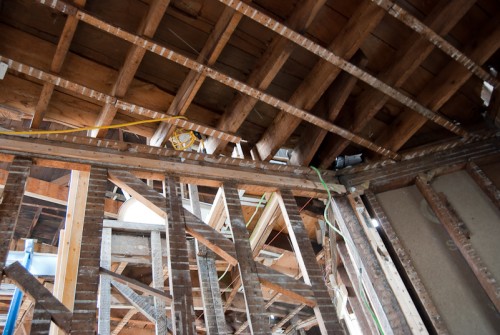 Innovation in progress. Excuse our dust. For more images from the JP Green House, visit Leise Jones Photography.I was bringing two new friends down the street for a tour of the JP Green House last week. “Now prepare yourselves,” I warned, as I always do, “it’s not bright shiny green yet. You’ll need to use your imagination.”
Innovation in progress. Excuse our dust. For more images from the JP Green House, visit Leise Jones Photography.I was bringing two new friends down the street for a tour of the JP Green House last week. “Now prepare yourselves,” I warned, as I always do, “it’s not bright shiny green yet. You’ll need to use your imagination.”
We rounded the corner and there it was: A hulking, gray house with a strange triangular shape on a prominent streetcorner. Gray shingles were falling off the exterior. Plastic tarps covered the gaping window-openings. In the garden, the grass grew tall around the dumpster and a huge pile of brush at the back was waiting to be shredded. Pumpkins and squash vines were spilling out over the raised beds of vegetables, and my attempt at making a flower bed had revealed my feeble knowledge of plant-aesthetics. Weeding was overdue. A large hillside on the north side of the garden was covered with blue tarps, smothering out our nemesis, the pernicious invasive weed Vincetoxicum.
Inside, I showed off the newly repaired foundation with pride, though to the untrained eye it is merely a concrete floor. The interior is entirely gutted, with no interior walls and only the frame to show. I verbally painted the vision for my guests: Picture the 12 inches of insulation and the polished concrete floors that will keep in the passive solar heat from the south walls; the solar panels and the mini wind turbines that will provide the minimal amount of electricity we’ll need for appliances.
Imagine a big open first floor with a kitchen and living room connected to the “community room,” which we will open to our neighbors for meetings, book groups, potlucks, climate-action planning, meditation, songfests, and a homeschooling collective. Imagine groups of schoolchildren visiting for tours of a zero-carbon house and discussions about the meaning of sustainability. Imagine the deck outside the kitchen, an herb garden, a thicket of berry bushes. Picture clean laundry waving in the breeze, and the Earth flag over the front door. I go on …
Most people get it; they see the vision as we describe it; they get excited. We are careful to talk about process, because we know it will be endless. When asked, I will expand the vision to include our sense of what our three children will learn from living in a demonstration home, learning to give tours, raise chickens and vegetables, and contemplate the future without paralyzing fear. And I will talk about the trouble and the passion of building a dream with the love of your life: fighting over money and housework and the kids, the grief of climate change we face together, the spiritual work of building together.
There are occasionally cynics, who point out how far we have to go. It’s okay — I am occasionally one of them.
It was an excellent week of climate news, much of it covered here on Grist. I watched with fascination as the comments accrued in response to Adam Sacks’ post about the need to tell the full, horrifying truth about the coming ecological crash. The same tension between despair and hope is everpresent in our household as well. Elizabeth Kolbert’s wonderful article about No Impact Man and other successors of Thoreau brought up an issue I talk about constantly: The very American desire to “fix yourself,” in this case “green your lifestyle” to degrees of near absurdity, usually as some sort of a time-limited personal project, which begs the question of whether these aren’t just gimmicks. This despite the clear evidence that climate change cannot be solved by millions of people making relatively easy “lifestyle changes.”
What makes us different? We have asked that question of ourselves and others and we are still answering it.
Part of the answer is just humility: A demonstration home is just that. We are trying to model a viable future, and be honest in the process about the difficulties and the compromises. (Ken insists on having a clothes dryer; I refuse to give up leather shoes; we have to drive all of our kids to school, because the schools in walking distance don’t please us.)
Another part of the answer is action. We are committed to our political work on climate (we are the Boston “hub” for 350.org), to the point where we neglect the house itself to do it.
The most gratifying news of the week for me was the announcement of the new initiative by the Yes Men, BeyondTalk. Go to BeyondTalk.net and pledge to engage in civil disobedience for climate change.
Ken and I discussed it. We decided that we would have to take turns doing actions, so that we don’t both get arrested at the same time. Someone has to take care of the house and the kids. And we considered whether we should set up a small fund for bail and other legal expenses. Then we went back to our discussion of our options for exterior siding: Should it be red? Definitely not green.


